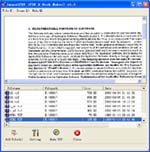
TIF to PDF Conversion - Convert TIF to PDF file (tif2pdf, tiftopdf)
|
|
TIF to PDF Converter - TIF to PDF TIF to PDF Conversion - Convert TIF to PDF file (tif2pdf, tiftopdf) |
TIF could be the format of choice
for archiving important images. TIF may possibly be the top industrial and
expert image standard. TIF is easily essentially the most universal and many
broadly supported format across all platforms, Mac, Residence windows, Unix.
Information as much as 48 bits is supported.
TIF supports most shade spaces, RGB, CMYK, YCbCr, and so on. TIF is genuinely a
versatile format with a lot of options. The data is made up of tags to declare
which kind of information follows. New varieties are easy to invent, which
flexibility could cause incompatibly, but about any system anyplace will handle
the standard TIF types that folks might encounter. TIF can store information
with bytes possibly in Mac or PC system (Apple or Motorola CPU chips differ in
by performing this). This choice enhances effectiveness, but all significant
applications nowadays can see TIF in possibly case, and TIF files could be
exchanged without any problem.
Many compression formats are utilized with TIF. TIF with G3 compression may be
the universal regular for fax and multi-page line artwork documents.
TIF image files optionally use LZW lossless compression. Lossless means there's
no quality loss due to the fact of compression. Lossless guarantees which you
could usually read back exactly that which you believed held on, bit-for-bit
identical, without information corruption. This can be a essential factor for
archiving master copies of essential pictures. Most image compression formats
are lossless, with Digital and Kodak PhotoCD PCD files being the main
exceptions.
Compression features by recognizing repeated identical strings inside the data,
and changing the numerous instances with one instance, in approaches that
permits unambiguous decoding with out reduction. This actually is relatively
intensive function, after which any compression approach tends to make files
reduced so that you can save or open.
LZW is perfect when blending reliable indexed colours (graphics), and it is less
efficient for 24 bit steady photograph pictures. Featureless locations compress
much better than detailed regions. LZW works far better for grayscale images
than coloration. It's regularly hardly successful whatsoever for 48 bit pictures
(VueScan 48 bit TIF LZW is definitely an exception for this, making use of an
effective information type that does not others use ).
TIF to PDF Converter SDK does support TWAIN function, TIF to PDF Converter SDK
is very easy to use. The simplest implementation is to scan a single image using
the device's user interface,
Dim new_image as imgdes ' Image descriptor
Dim rcode as long ' Return code
rcode = TWscanimage(hWnd, new_image)
And to save the image in a TIF file . . .
rcode = savetif("newimage.tif", new_image, 0)
In addition to being easy, the TWAIN device of TIF to PDF Converter SDK is
powerful. You can hide the user interface, control the scan conditions, and
capture multiple images.
After you get the TIF image files, you can use following VB.NET code to convert
these TIF files to PDF files,
Public
Function
AddImage(ByRef
pdfObject As
Object,
ByVal
FileID As
Long,
ByVal
Image As
String)
Dim code
Dim
width
Dim height
Dim xdpi
Dim ydpi
'ImageName = pdfFilePath + Image
ImageName = Image
bresult = pdfObject.com_VerySetFunction(FileID,
Very_Set_PreProcessImage, 1, 0, 0, 0)
'get width height
code = 202
width = pdfObject.com_VeryGetFunction(FileID,
code, 0, 0, ImageName, 0)
'Response.Write "width:" & width &
"</br>"
code = 203
height = pdfObject.com_VeryGetFunction(FileID,
code, 0, 0, ImageName, 0)
'Response.Write "height:" & height
& "</br>"
'get dpi
code = 204
xdpi = pdfObject.com_VeryGetFunction(FileID, code,
0, 0, ImageName, 0)
'Response.Write "xdpi:" & xdpi &
"</br>"
code = 205
ydpi = pdfObject.com_VeryGetFunction(FileID, code,
0, 0, ImageName, 0)
'Response.Write "ydpi:" & ydpi &
"</br>"
If
xdpi > 0 And
ydpi > 0 Then
width = (width * (58 / xdpi))
height = (height * (58 / ydpi))
Else
width = (width * (62 / xdpi))
height = (height * (62 / ydpi))
End
If
Dim startx
Dim starty
startx = (612 / 2) - (width / 2)
' bresult =
pdfObject.com_VerySetFunction(FileID, 104, 20, 110, CStr(width), CStr(height))
starty = (792 / 2) - (height / 2)
bresult = pdfObject.com_VerySetFunction(FileID,
104, startx, starty, CStr(width),
CStr(height))
'add image one
bresult = pdfObject.com_VeryAddImage(FileID,
ImageName)
End
Function
Private
Sub
Command1_Click()
Dim pdfObj
As
Object
Set pdfObj =
CreateObject("pdfshell.shellexe")
'Create a PDF file
id = pdfObj.com_VeryCreate(App.Path &
"\image2pdf.pdf")
AddImage pdfObj, id, App.Path &
"\001.tif"
AddImage pdfObj, id, App.Path &
"\002.tif"
AddImage pdfObj, id, App.Path &
"\003.tif"
AddImage pdfObj, id, App.Path &
"\004.tif"
AddImage pdfObj, id, App.Path &
"\005.tif"
AddImage pdfObj, id, App.Path &
"\006.tif"
pdfObj.com_VeryClose (id)
End
Sub
Home |
Products |
Downloads |
Support |
Links | Contact
Copyright © 2000- VeryPDF.com, Inc. All rights reserved.
Send comments about this site to the webmaster.